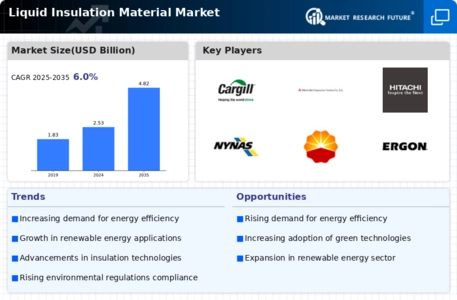Leading market players are investing heavily in the research and development in order to expand their product lines, which will help the Liquid Insulation Material Market grow even more. Market players are also undertaking a variety of strategic activities to spread their global footprint, with important market developments including mergers and acquisitions, new product launches, contractual agreements, higher investments, and collaboration with other organizations. To spread and survive in a more competitive and rising market climate, the Liquid Insulation Material industry must offer cost-effective items.
Manufacturing locally to minimize the operational costs is one of the key business tactics used by the manufacturers in the global Liquid Insulation Material industry to benefit the clients and increase the market sector. In recent years, the Liquid Insulation Material industry has offered some of the most significant advantages to different industries. Major players in the Liquid Insulation Material Market, including Cargill, Mitsubishi Corporation, Hitachi, ABB, Guangrun Shida, M&I Materials, ZDOIL, Nynas, Petro China, Ergon, and others, are trying to increase market demand by investing in research and development operations.
ABB, or Asea Brown Boveri, is a multinational Swiss-Swedish conglomerate renowned for its pioneering role in the field of robotics, automation, and electrical engineering. With a history dating back to the late 19th century, ABB has evolved into a global leader, offering a broad range of products and services that contribute significantly to the energy and industrial sectors. The company is recognized for its innovative solutions in power grids, electrification, industrial automation, and motion.
ABB's commitment to sustainability is evident through its emphasis on developing technologies that enhance energy efficiency, reduce environmental impact, and promote the widespread adoption of renewable energy sources. ABB and Hitachi Energy announced a partnership in 2022 to combine their expertise in high voltage and grid automation technologies, potentially impacting liquid insulation materials used in their products.
Mitsubishi Corporation, a globally renowned Japanese conglomerate, stands as a diversified enterprise with a presence in various sectors such as finance, industry, energy, and more. Established in 1950, Mitsubishi Corporation has evolved into one of Japan's largest and most influential trading companies. With a robust global network and strategic investments, the company engages in activities ranging from natural resources development, manufacturing, and infrastructure projects to finance and new technology ventures. Mitsubishi Corporation's commitment to sustainability is evident through its participation in initiatives focused on environmental and social responsibility.
Shell and Mitsubishi Electric collaborated in 2020 to develop new transformer oils with improved biodegradability and performance, furthering research in bio-based liquid insulation materials.


















Leave a Comment